Beretta M9A1 9mm 10 Round Pistol, Black – JS92M9A1 For Sale
$678.97
What is the difference between the Beretta M9 and the M9A1?
The primary differences between the Beretta M9 and the M9A1 are as follows:
1. **Rail System**: The M9A1 features a Picatinny rail integrated into the frame in front of the trigger guard, allowing for the attachment of tactical lights, lasers, and other accessories. The original M9 does not have this rail.
2. **Grip Design**: The M9A1 has an aggressively checkered front and backstrap grip for improved hold, which is designed to offer better control, especially in adverse conditions.
3. **Magazines**: The M9A1 includes magazines with PVD (Physical Vapor Deposition) coating to improve performance and reduce corrosion in challenging environments.
4. **Enhanced Sights**: The M9A1 features slightly upgraded three-dot sighting systems for better target acquisition.
These enhancements in the M9A1 were aimed at improving the functionality and tactical versatility as compared to the original M9, which has been a standard issue sidearm for the U.S. armed forces.
Which is better, M9A1 or 92A1?
The choice between the Beretta M9A1 and 92A1 depends on your specific needs and preferences, as both are variations of the Beretta 92 series and have their respective features.
**M9A1:**
– Originally designed for military use, the M9A1 includes a standard Picatinny rail for mounting accessories.
– It features a corrosion-resistant finish and checkered grip for improved handling.
– Generally known for its reliability and durability.
**92A1:**
– Built with a recoil buffer to reduce felt recoil and increase durability.
– Has a removable front sight for customization and improved aiming.
– Also comes with a Picatinny rail, like the M9A1, but includes a higher magazine capacity option (17 rounds).
**Conclusion:**
If you prioritize durability and a pistol that’s closer to military specifications, the M9A1 might be preferable. However, if you want a model with additional features like reduced recoil and customizable sights, the 92A1 may be the better choice. Consider what features are most important to you, such as recoil management, customization options, or military-grade design, to make the best decision for your use case.
Is the Beretta M9 illegal?
The legality of the Beretta M9, as with any firearm, depends on the specific laws and regulations of the jurisdiction in question. In the United States, the Beretta M9 is generally legal to own in most states, provided that the owner complies with federal, state, and local gun laws, such as background checks and any necessary permits or licenses. However, some states and localities may have specific restrictions or bans on certain types of firearms, including handguns like the M9. It’s important to check the local laws where you reside to ensure compliance. If you’re outside the United States, the legality could vary significantly based on the country’s firearm laws.
What Beretta did the Navy SEALs use?
The Navy SEALs have used the Beretta M9 as their standard sidearm. However, it is worth noting that Special Operations Forces, including the SEALs, often have access to a variety of firearms and may use different pistols based on mission requirements.
What are the flaws of the Beretta M9?
The Beretta M9, while widely used and generally reliable, has faced criticism and scrutiny over several issues:
1. **Size and Weight**: Some users find the M9 to be relatively large and heavy, particularly compared to more modern handguns designed for the same purpose. This can make it cumbersome for some users, especially in terms of carry and use in the field.
2. **Trigger Mechanism**: The M9 features a double-action/single-action (DA/SA) trigger, which requires an initial heavy pull followed by lighter subsequent pulls. This can lead to inconsistency in accuracy, especially during rapid fire or for those not accustomed to DA/SA action.
3. **Grip Size**: The full-sized grip of the M9 may not be ideal for individuals with smaller hands, potentially affecting their ability to handle the pistol comfortably and securely.
4. **Durability and Reliability**: While generally reliable, early versions of the M9 reportedly faced issues with parts like locking blocks and slides, leading to concerns over longevity under extensive use. Over time, modifications and improvements have addressed many of these issues.
5. **Sight System**: The standard sights on the M9 are fixed and can be difficult to adjust. Some users have found them less effective in low-light conditions or during rapid target acquisition.
6. **Safety and Decocker**: The safety/decocking lever can be seen as cumbersome or awkwardly positioned for some users, potentially hindering quick deployment.
7. **Magazine Capacity**: The M9’s standard magazine holds 15 rounds. While adequate, other modern handguns offer higher-capacity magazines in similar or more compact frames.
8. **Maintenance Requirements**: Some criticisms have been made regarding the frequency and level of maintenance required to ensure optimal function and reliability, especially in challenging environments.
While these are noted concerns, many of them have been addressed in newer models and variants. However, they offer important considerations for anyone evaluating the M9 for personal or official use.
What Beretta did Mel Gibson use?
Mel Gibson’s character, Martin Riggs, used a Beretta 92FS in the “Lethal Weapon” film series.
Is Beretta M9 better than 92FS?
The Beretta M9 and the 92FS are very similar, as the M9 is essentially a military designation for a version of the 92FS. Both models are manufactured by Beretta and share many aspects such as design, caliber (9mm), and operation mechanism. However, there are some minor differences:
1. **Markings and Designations**: The M9 often includes specific military markings and has a different designation purely for military use.
2. **Sights**: Some M9 models come with dot-and-post sights, whereas the 92FS typically has three-dot sights.
3. **Slide Design**: The M9 has a slightly different slide design with a different contour in certain models.
4. **Finish**: There can be subtle differences in the finish, with military M9 variants often having specifications unique to military contracts.
In terms of performance, reliability, and mechanics, both are virtually the same. Therefore, determining which is “better” is largely a matter of personal preference based on these slight differences and intended use (military vs. civilian).
Will a Beretta 96A1 fit in a 92A1 holster?
Yes, a Beretta 96A1 will typically fit in a holster designed for a Beretta 92A1. Both models have similar dimensions and frame sizes, which often allows them to be used interchangeably in holsters made for the other model. However, it’s always best to verify with the specific holster manufacturer to ensure a proper fit, as designs can vary.
What size mag does a Beretta M9A1 take?
The Beretta M9A1 typically uses a magazine that holds 15 rounds of 9mm ammunition. However, there are also higher-capacity magazines available, including options for 17 and 20 rounds.
What pistol do Navy SEALs carry?
Navy SEALs primarily carry the SIG Sauer P226 and the newer SIG Sauer P320, designated in the military as the M17.
Can a civilian buy an M9 Beretta?
Yes, a civilian can buy an M9 Beretta, as it is a semi-automatic pistol available for civilian purchase in many places. However, the purchase is subject to federal, state, and local laws and regulations regarding firearm sales and ownership. Buyers typically need to pass a background check and follow any rules specific to their location.
Why did the military stop using the Beretta M9?
The military decided to replace the Beretta M9 primarily due to its age and the desire for a firearm with more modern features. The M9, adopted in 1985, was seen as outdated, and the military sought a handgun with improved modularity, ergonomics, and adaptability to different missions. This led to the selection of the SIG Sauer P320, designated as the M17 (full-size) and M18 (compact) under the Modular Handgun System program. The new pistols offer advancements such as enhanced durability, increased capacity, and the ability to easily change parts to suit different requirements, which aligns better with current military needs.
What caliber is a Beretta m9a1?
The Beretta M9A1 is chambered in 9mm.
What is the difference between the Beretta M9A3 and the M9A4?
The Beretta M9A3 and M9A4 have several key differences:
1. **Optics Ready**: One of the most significant differences is that the M9A4 is optics-ready, featuring a slide cutout that allows for the attachment of red dot sights, which is not present on the M9A3.
2. **Barrel**: Both models share the same threaded barrel, but the M9A4 may have some refinements or variations suited for compatibility with more modern suppressors.
3. **Rail System**: The M9A4 might feature enhancements to its accessory rail system, although both models generally accommodate similar accessories.
4. **Grip Texture**: There could be variations in the grip texture or ergonomics between the M9A3 and M9A4, with the latter potentially offering improved handling features.
5. **Trigger**: Any updates to the trigger system or trigger pull can affect the performance feel, making the M9A4 potentially more refined than the M9A3.
6. **Color Options**: The M9A4 might be available in different finishes compared to the M9A3, potentially catering to aesthetic preferences.
These differences make the M9A4 generally more adaptable to modern shooting accessories and preferences, while still retaining the core features of the M9 series.
What is the difference between the M9 and the FS?
The M9 and the FS refer to two variations of Beretta’s 9mm semi-automatic pistols. Here are the key differences:
1. **Designation and Use**:
– **M9**: The M9 is the military designation for the Beretta 92FS. It was adopted by the United States Armed Forces as their standard issue sidearm in 1985.
– **FS**: The 92FS is the civilian designation for essentially the same firearm, available on the commercial market.
2. **Markings and Features**:
– **M9**: Features specific military markings, such as “U.S. 9mm M9” on the slide, and may include other military-specific features like a lack of a civilian warning label.
– **FS**: Typically features the Beretta logo and “Model 92FS” markings, with additional safety warnings as required for civilian firearms.
3. **Sights**:
– While both typically have similar three-dot sight systems, some M9 models might have a slightly different rear sight that accommodates the military’s specifications.
4. **Finish and Exterior**:
– Differences in finish or coatings might exist, with the M9 potentially having more robust finishes suitable for military environments.
Functionality-wise, both pistols are practically identical and have interchangeable parts. The differences are mainly in designation, markings, and minor features to suit their intended user base.
Be the first to review “Beretta M9A1 9mm 10 Round Pistol, Black – JS92M9A1” Cancel reply
Related products
Beretta M9A1
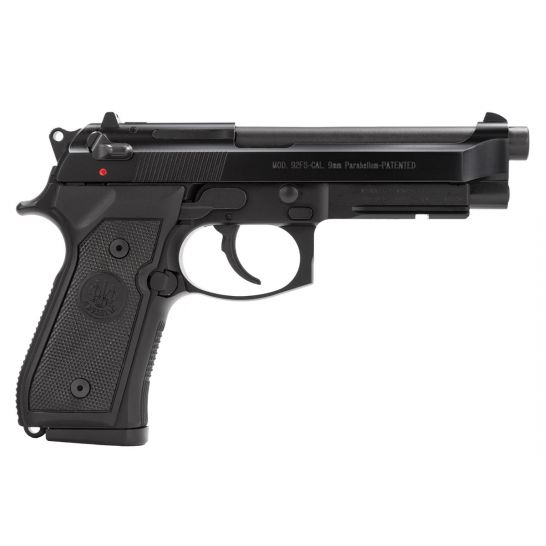
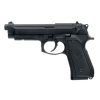
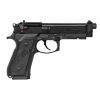
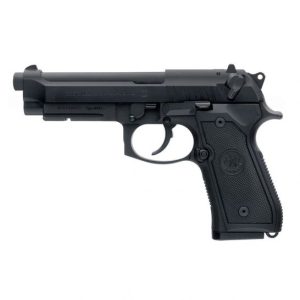
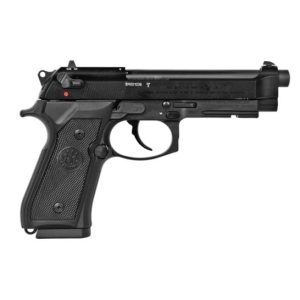
Reviews
There are no reviews yet.